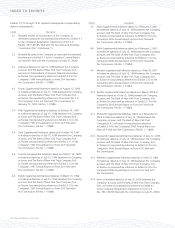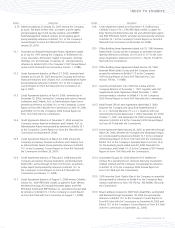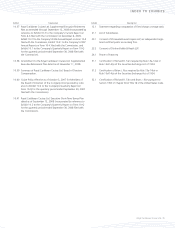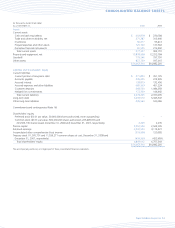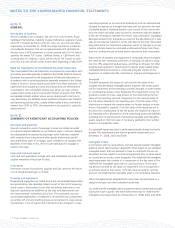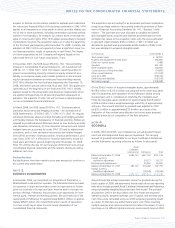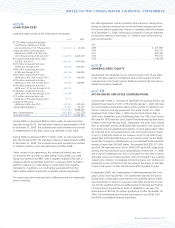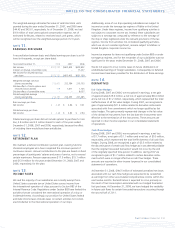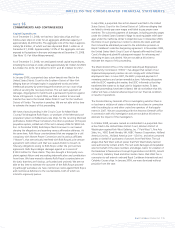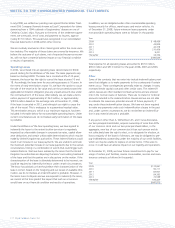Royal Caribbean Cruise Lines 2008 Annual Report Download - page 62
Download and view the complete annual report
Please find page 62 of the 2008 Royal Caribbean Cruise Lines annual report below. You can navigate through the pages in the report by either clicking on the pages listed below, or by using the keyword search tool below to find specific information within the annual report.
NOTES TO THE CONSOLIDATED FINANCIAL STATEMENTS
F-7 Royal Caribbean Cruises Ltd.
NOTE 1.
GENERAL
Description of Business
We are a global cruise company. We own five cruise brands, Royal
Caribbean International, Celebrity Cruises, Pullmantur, Azamara Cruises,
and CDF Croisières de France with 20, nine, six, two and one ships,
respectively, at December 31, 2008. Our ships operate on a selection
of worldwide itineraries that call on approximately 425 destinations.
We also have a 50% investment in a joint venture with TUI AG which
operates the brand TUI Cruises. Celebrity Galaxy, a 1,850-berth ship
currently part of Celebrity Cruises, will be sold to TUI Cruises to serve
as its first ship and will sail under a new name beginning in May 2009.
Basis for Preparation of Consolidated Financial Statements
The consolidated financial statements are prepared in accordance with
accounting principles generally accepted in the United States of America.
Estimates are required for the preparation of financial statements in
accordance with accounting principles generally accepted in the United
States of America. Actual results could differ from these estimates. All
significant intercompany accounts and transactions are eliminated in
consolidation. We consolidate entities over which we have control,
usually evidenced by a direct ownership interest of greater than 50%
and variable interest entities where we are determined to be the pri-
mary beneficiary. For affiliates where significant influence over financial
and operating policies exists, usually evidenced by a direct ownership
interest from 20% to 50%, the investment is accounted for using the
equity method.
NOTE 2.
SUMMARY OF SIGNIFICANT ACCOUNTING POLICIES
Revenues and Expenses
Deposits received on sales of passenger cruises are initially recorded
as customer deposit liabilities on our balance sheet. Customer deposits
are subsequently recognized as passenger ticket revenues, together
with revenues from onboard and other goods and services and all
associated direct costs of a voyage, upon completion of voyages with
durations of ten days or less, and on a pro rata basis for voyages in
excess of ten days.
Cash and Cash Equivalents
Cash and cash equivalents include cash and marketable securities with
original maturities of less than 90 days.
Inventories
Inventories consist of provisions, supplies and fuel carried at the lower
of cost (weighted-average) or market.
Property and Equipment
Property and equipment are stated at cost less accumulated depreciation
and amortization. We capitalize interest as part of the cost of acquiring
certain assets. Improvement costs that we believe add value to our
ships are capitalized as additions to the ship and depreciated over
the improvements’ estimated useful lives. The estimated cost and
accumulated depreciation of replaced or refurbished ship components
are written off and any resulting losses are recognized in cruise operat-
ing expenses. Costs of repairs and maintenance are charged to cruise
operating expenses as incurred and drydocking costs are deferred and
charged to expense on a straight-line basis over the period to the next
scheduled drydock. Deferred drydock costs consist of the costs to dry-
dock the vessel and other costs incurred in connection with the drydock
which are necessary to maintain the vessel’s class certification. Liquidated
damages received from shipyards as a result of the late delivery of a new
ship are recorded as reductions to the cost basis of the ship. We review
long-lived assets for impairment whenever events or changes in circum-
stances indicate, based on estimated undiscounted future cash flows,
that the carrying amount of these assets may not be fully recoverable.
Depreciation of property and equipment is computed using the straight-
line method over estimated useful lives of primarily 30 years for ships,
net of a 15% projected residual value, and three to 40 years for other
property and equipment. Depreciation for assets under capital leases
and leasehold improvements is computed using the shorter of the
lease term or related asset life. (See Note 6. Property and Equipment.)
Goodwill
Goodwill represents the excess of cost over the fair value of net
tangible and identifiable intangible assets acquired. We review good-
will for impairment at the reporting unit level annually, or when events
or circumstances dictate, more frequently. The impairment review for
goodwill consists of a two- step process of first determining the fair
value of the reporting unit and comparing it to the carrying value of
the net assets allocated to the reporting unit. If the fair value of the
reporting unit exceeds the carrying value, no further analysis or write-
down of goodwill is required. If the fair value of the reporting unit is
less than the carrying value of the net assets, the implied fair value of
the reporting unit is allocated to all the underlying assets and liabilities,
including both recognized and unrecognized tangible and intangible
assets, based on their fair value. If necessary, goodwill is then written
down to its implied fair value.
Our goodwill impairment test is performed annually during the fourth
quarter. We determined there was no goodwill impairment as of
December 31, 2008, 2007 and 2006.
Intangible Assets
In connection with our acquisitions, we have acquired certain intangible
assets of which value has been assigned to them based on our estimates.
Intangible assets that are deemed to have an indefinite life are not
amortized, but are subject to an annual impairment test, or when events
or circumstances dictate, more frequently. The indefinite-life intangible
asset impairment test consists of a comparison of the fair value of the
indefinite-life intangible asset with its carrying amount. If the carry-
ing amount exceeds its fair value, an impairment loss is recognized in
an amount equal to that excess. If the fair value exceeds its carrying
amount, the indefinite-life intangible asset is not considered impaired.
Other intangible assets assigned finite useful lives are amortized on a
straight-line basis over their estimated useful lives.
Our indefinite-life intangible assets impairment test is performed annually
during the fourth quarter. We determined there was no indefinite-life
intangible asset impairment as of December 31, 2008, 2007 and 2006.


